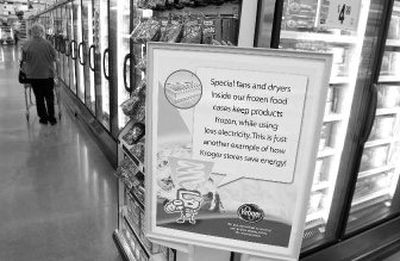Grocers going green

LOVELAND, Ohio — Grocery shoppers at the new Kroger store in this eastern Cincinnati suburb are bathed in sunlight from 75 skylights in rows overlooking the aisles.
It’s the most noticeable among many features aimed at reducing energy use by the nation’s largest traditional grocery store chain. The store also has compact fluorescent lights that require less electricity and last 10 times longer than traditional bulbs. Motion detectors help shut off lights when areas are vacated. The store recycles exhaust to heat water, uses more-efficient plastic fans instead of metal ones, and has concrete floors that can be cleaned with water instead of chemicals used for tile.
The grocery business is getting greener, led by new initiatives from chains such as Kroger Co., Wal-Mart Stores Inc. and Tesco PLC. They’re part of a broad range of businesses, including giants such as General Electric Co., General Motors Corp. and Exxon Mobil Corp., are reacting to increasing public concern about energy issues.
The trend is particularly noticeable among grocery stores, a regular stop for American shoppers. Kroger, with nearly 2,500 stores in 31 states, says 40 percent of all American households have one of its shopper loyalty cards.
For grocers, energy savings are part of a critical effort to cut costs and deal with tighter profit margins as Wal-Mart and other discounters build up their grocery aisles.
The efforts make financial and public relations sense, environmentalists say on the eve of Sunday’s annual Earth Day activities.
“Given our size, we have a certain amount of responsibility to the environment and to being a good citizen,” said Rodney McMullen, Kroger’s vice chairman. “We take everything we save with the energy reductions and we reinvest it with the customer … in lower prices or in improved service.”
Kroger, which had $66 billion in 2006 revenues, says energy consumption is down 20 percent since 2000 thanks to efforts ranging from new, more-efficient technology to pushing common sense steps like turning lights off when not needed. Company officials say it’s hard to state a total financial savings because energy prices have been rising, but estimate it at tens of millions of dollars.
“It’s a critical cost element that they still have some room to improve upon,” said Craig Hutson, an analyst at the corporate bond research firm Gimme Credit. “In an environment where it’s intensely competitive from a pricing standpoint, whatever you can do on costs is going to help you generate profits.”
Dave Hamilton, director of the Sierra Club’s global warming and energy program, said grocers, with many power needs such as refrigeration, can help their images while saving money.
“Kroger and Wal-Mart and others who are making these changes are definitely winning on the bottom line as well as starting to have something to show customers that they are doing the things we need to do,” Hamilton said. He said the chains have also increased organic food offerings because of customer demand.
Salisbury, N.C.-based Food Lion LLC, subsidiary of the Brussels, Belgium-based Delhaize Group, has been an industry leader since targeting energy costs consuming 7 percent to 10 percent of its operating costs nearly a decade ago. Food Lion spokeswoman Kimberly Blackburn said the chain had been looking for ways to reduce overhead so it could keep prices down, and decided to partner with the federal Environmental Protection Agency in a program to cut energy use.
Among technologies Food Lion has adopted are demand control systems that cut energy use during non-peak times, heat reclamation, more-efficient refrigeration and automated lighting. Food Lion says it has cut energy use 27 percent.